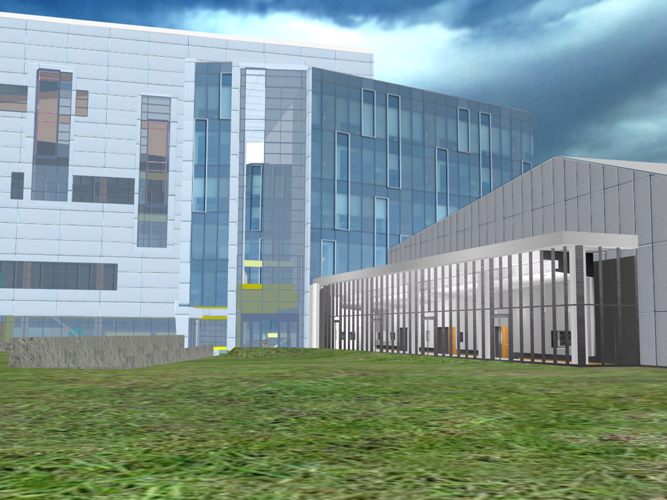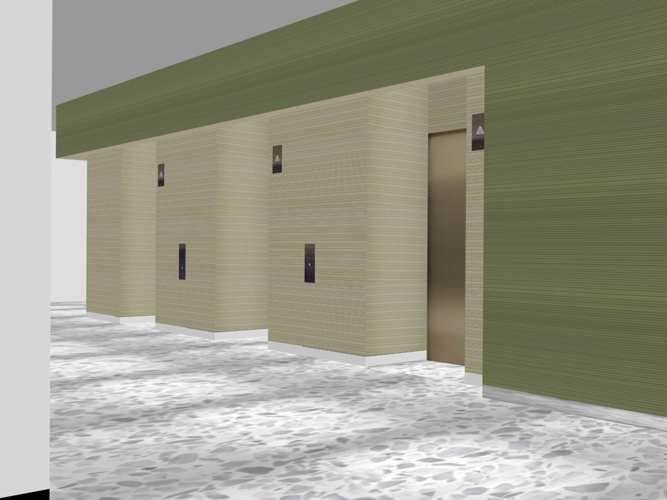Difference between revisions of "Virtual Calit2 Building"
(→Contributors) |
|||
| Line 15: | Line 15: | ||
[http://ivl.calit2.net/wiki/index.php/User:mezhang Mabel Zhang]. | [http://ivl.calit2.net/wiki/index.php/User:mezhang Mabel Zhang]. | ||
| − | ==Images== | + | |
| + | ==Project Details== | ||
| + | |||
| + | |||
| + | ===Dynamic Elements=== | ||
| + | ====Automatic Doors==== | ||
| + | |||
| + | |||
| + | ====Working Elevators==== | ||
| + | |||
| + | |||
| + | ====Light Effects==== | ||
| + | |||
| + | |||
| + | ====VRML Scripting in General==== | ||
| + | |||
| + | |||
| + | |||
| + | |||
| + | ===Modeling in Autodesk 3ds Max=== | ||
| + | |||
| + | |||
| + | |||
| + | |||
| + | ===Optimization=== | ||
| + | |||
| + | The difference between a very nicely and smoothly rendered architectural scene and a real-time 3D model is that the former allows for rendering ahead of the time, and the latter requires rendering on the fly. Because of this, in order to reach the maximum navigation speed in the architectural model, some details need to be sacrificed; this includes the smoothness of surfaces, details in objects, resolution of textures, etc. The VRML language itself already has some features to enable fast real-time rendering such as the lack of shadows so that no shadows will need to be calculated for rendering; this is also part of the reason that VRML does not support all of the effects from 3ds Max, and the non-supported features are not exported to VRML files when using the 3ds Max exporter. | ||
| + | |||
| + | Our main approach was to reduce the polygon count, to shrink texture file size, and to reuse textures. | ||
| + | |||
| + | ....more to come | ||
| + | |||
| + | |||
| + | ===Calit2 Model Structure=== | ||
| + | |||
| + | |||
| + | |||
| + | |||
| + | |||
| + | ===Misc. Debugging Ideas and Tricky Things=== | ||
| + | |||
| + | |||
| + | |||
| + | |||
| + | |||
| + | |||
| + | ===Future Work=== | ||
| + | |||
| + | |||
| + | |||
| + | |||
| + | |||
| + | |||
| + | ===More Images=== | ||
The Calit2 building viewed in wireframe mode. | The Calit2 building viewed in wireframe mode. | ||
Revision as of 19:09, 20 August 2008
The goal the Virtual Calit2 Building is to provide an accurate and accessible virtual replica of the Calit2 building that can be used by any researcher or scientist to conduct projects or tests that require the need for a detailed architectural layout.
Contents |
Proposed Projects Using the Virtual Calit2 Building
Contributors
Daniel Rohrlick continues making further additions to the existing model. The first floor of the Calit2 building is coming closer to completion.
Philip Weber provided excellent assistance with model loading techniques.
Project Details
Dynamic Elements
Automatic Doors
Working Elevators
Light Effects
VRML Scripting in General
Modeling in Autodesk 3ds Max
Optimization
The difference between a very nicely and smoothly rendered architectural scene and a real-time 3D model is that the former allows for rendering ahead of the time, and the latter requires rendering on the fly. Because of this, in order to reach the maximum navigation speed in the architectural model, some details need to be sacrificed; this includes the smoothness of surfaces, details in objects, resolution of textures, etc. The VRML language itself already has some features to enable fast real-time rendering such as the lack of shadows so that no shadows will need to be calculated for rendering; this is also part of the reason that VRML does not support all of the effects from 3ds Max, and the non-supported features are not exported to VRML files when using the 3ds Max exporter.
Our main approach was to reduce the polygon count, to shrink texture file size, and to reuse textures.
....more to come
Calit2 Model Structure
Misc. Debugging Ideas and Tricky Things
Future Work
More Images
The Calit2 building viewed in wireframe mode.

The Calit2 Building shown with photo-realistic textures.

A view of the interior lobby of Calit2.
